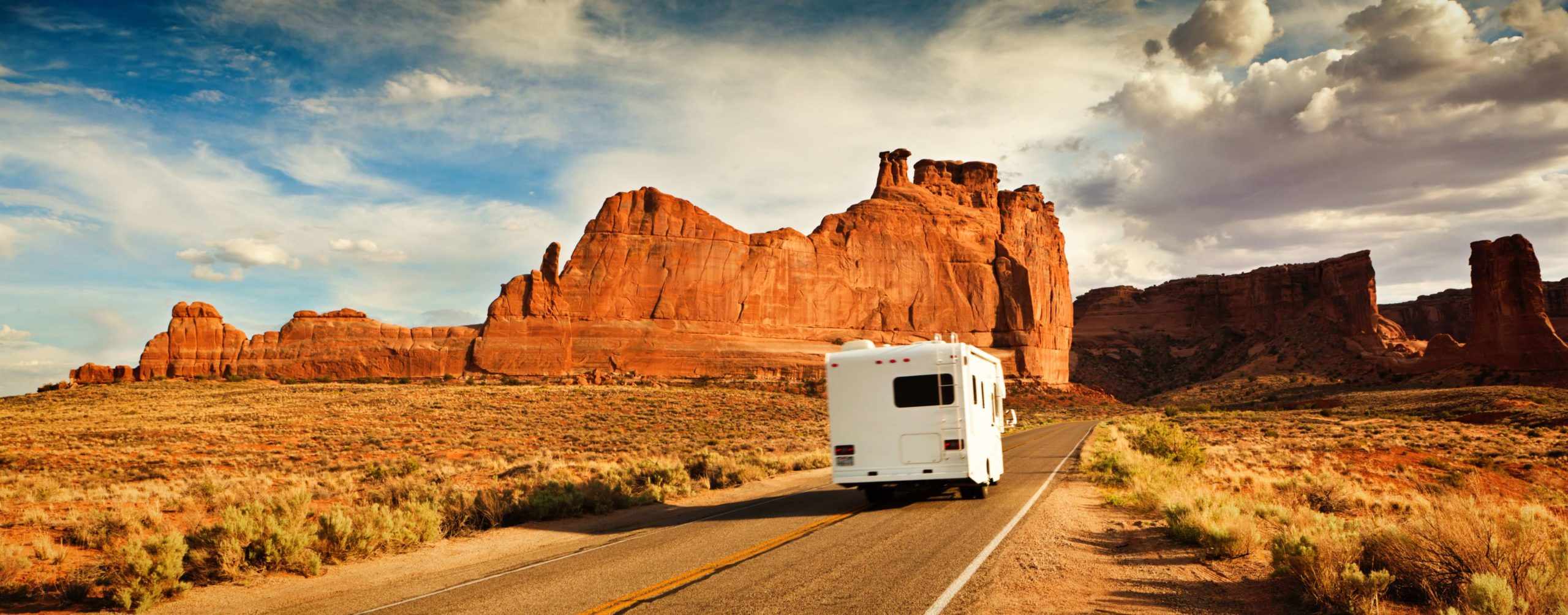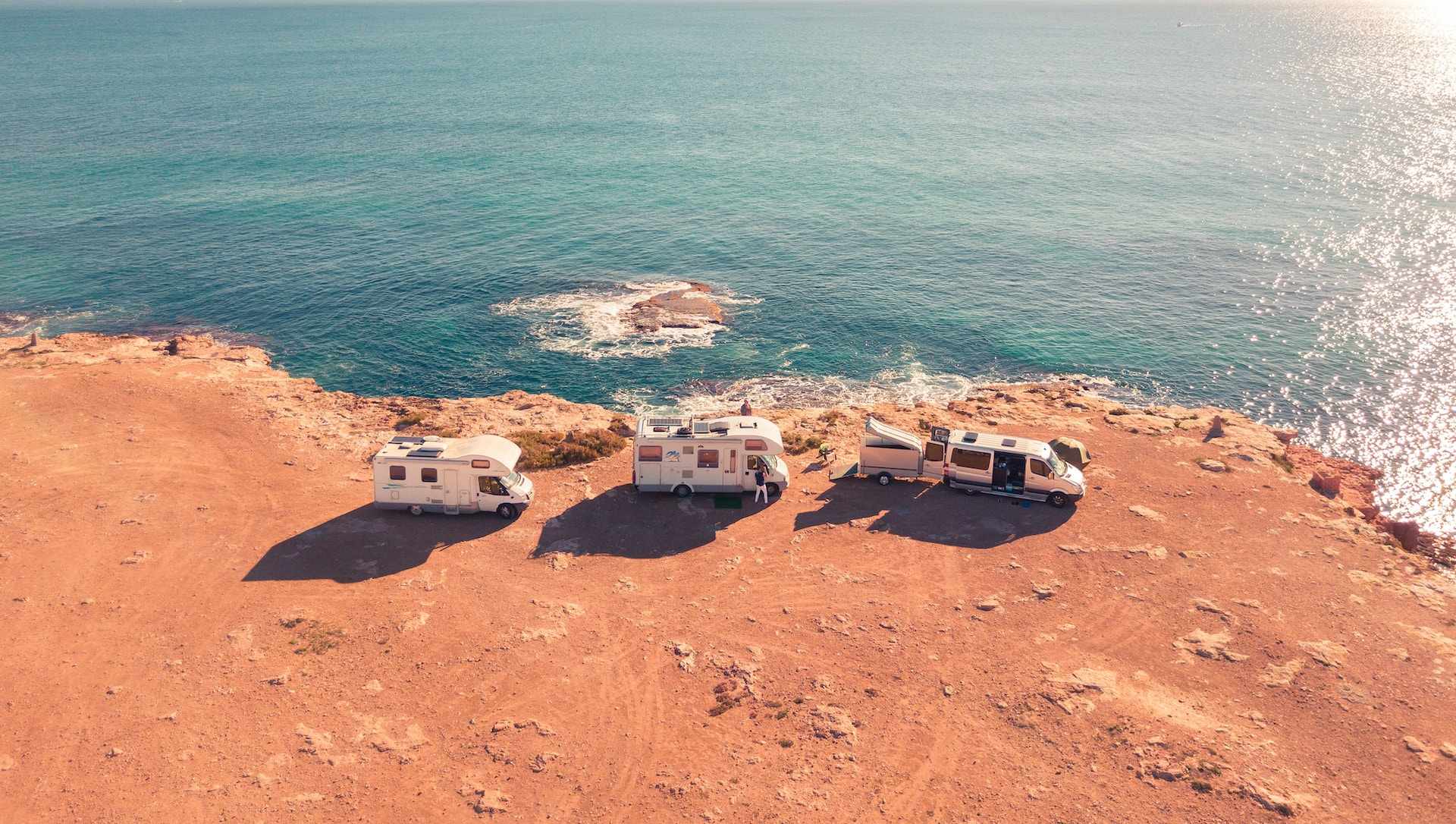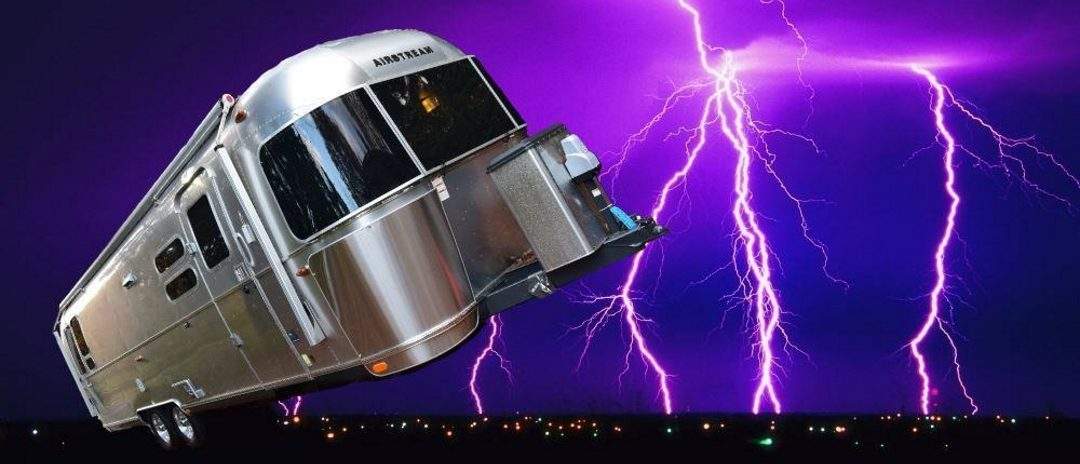Whether you are renting an RV on Outdoorsy for the first time or purchasing an RV for travel or to rent out to others, it’s important to learn the basics of RV electrical systems. Read on for a basic understanding of your RV electricity systems, how they work, and what to be aware of in terms of safety.
And if you need to stock up on things like batteries, cords, and inverters, check out our Amazon RV shop right here.
RVs for Rent Near You
In this guide, we’ll cover:
- Understanding AC vs. DC
- Power sources
- Fuses
- Propane vs electricity
- Surge protectors
Understanding AC vs. DC
The majority of rigs have two electrical RV systems. There is an AC (alternating current) system that is similar to the one in a typical home. There is also a DC (direct current) system that works similarly to the one in a car. The AC system is powered by plugging your trailer into an external AC power source, while the DC system runs off one or more battery systems installed in your RV. Big appliances like the air conditioning, microwave, and power outlets, run off the AC power system. Your lights, water pump, fans, TV, and radio run off the DC power system. The AC system is capable of generating a lot more power than the DC system, which is limited by your RV batteries.
The two RV electrical systems are connected so that if you have AC power coming into your RV, it will charge the batteries for the DC system. The device that does this is called a converter. Along with the RV power converter, many rigs also have an inverter, which turns DC power into AC power. RVs with an inverter will have specially marked wall outlets that run on the DC battery system but provide AC power.
Most RVs are set up so that if you have RV shore power (more about that later), you can run almost everything in the RV. If you don’t have shore power, you run off the DC system, which can run the essentials like the lights and water pump for a few days.
TIP: Use your RV electricity sparingly when unplugged
In short, if you’re plugged into a power source, feel free to enjoy and indulge in all the comforts of home. BUT if you are running off a battery, say while boondocking, use just the basics and sparingly!
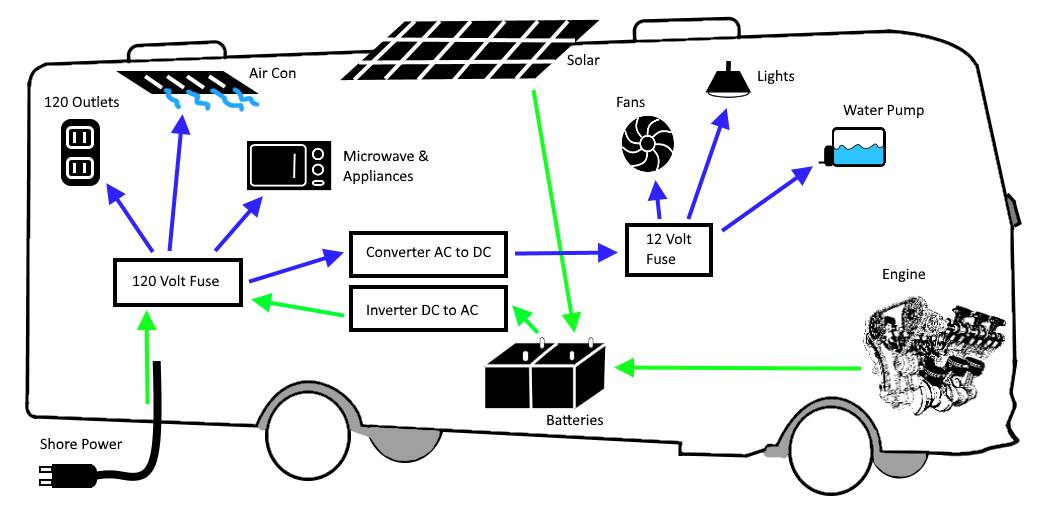
Power Sources
Let’s take a quick look at each of the sources of power for an RV.
Let’s take a quick look at each of an RV’s power sources. Please also refer to our RV electrical system schematic above.
RV batteries
Most RVs have one or more batteries. The batteries provide your RV with a source of power when no external power is available. The amount of power the batteries can provide on their own is fairly low — they can run the lights, water pump, and small appliances for the better part of the day, but that is about it. They can’t drive the air conditioning or heating systems either.
Your battery is charging any time an external power source is connected and providing power to your RV. Power sources include shore power, a generator, a vehicle engine, or a solar panel. When you are in motion, if you are plugged into a vehicle using the trailer adapter, the vehicle engine should charge your battery.
Shore power
RV shore power is when you can plug your RV into an AC electrical grid. The available power you can draw on is measured in amps. The most common RV connections are 30 amps and 50 amps. You can connect your RV to a line running from someone’s house, but use caution. To charge an RV from a house, the RV would need to connect to the home system using either an adapter or the house would need a designated 30 or 50-amp connection.
Your RV will be set up to use 50 amps or 30 amps, depending on its size. You can connect your RV to a lower-amp power source, but if you aren’t careful, it can be dangerous; you can damage the electrical systems if you try to draw more power than the shore power line is rated for. Typically, the worst thing is you blow fuses, but you could damage the power source or your trailer.
When you connect to shore power at an RV park, a circuit breaker will be on the pedestal. Remember to turn that on after you hook up to electricity, and turn it off when you disconnect to leave.
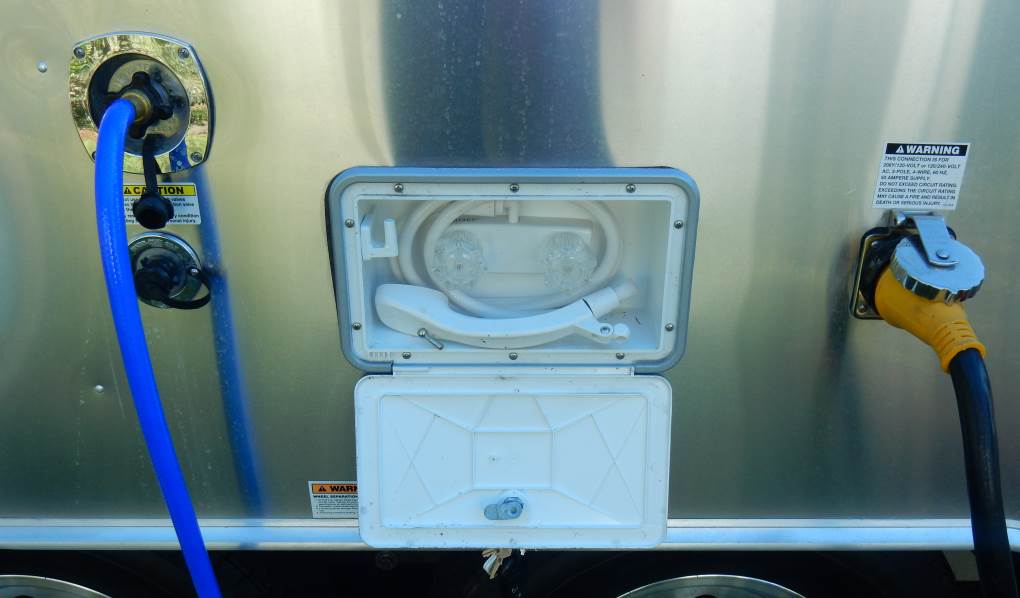
Generators
Generators work like RV shore power as they plug into your AC system and provide AC power. Typically, they don’t provide as much RV power as shore power does, but that really depends on the size of the generator.
Generators are rated in watts rather than amps. A 1000-watt generator is about right for a small RV or if you don’t need to run major systems like air conditioning. A 3500-watt generator is usually the next step up and can run most RV systems on most RVs.
Overdrawing a generator is not as risky as overdrawing shore power. If you try to overdraw a generator, you simply won’t get enough power to make everything run properly. Overloading your generator might damage some appliances, though it is not likely.
Some motorhomes have a built-in generator, which is separate from the main engine and usually located in an outside bay. These can be especially handy as they are insulated and thus not very noisy.
External generators are prohibited during quiet hours, especially at night. The most important safety rule for external generators is never to use them indoors since they produce a lot of carbon monoxide gas, and it can become fatal very quickly in an enclosed space.
Note: If you must use an external generator, you should never operate the generator indoors since carbon monoxide gas can build up in enclosed spaces.
Solar and wind
The important thing to understand about renewable energy sources is that they are designed to charge your battery, not to provide you with on-demand power.
They generate DC current rather than the AC power you get from shore power and generators. Thus, you are still limited by the amount of power your battery can provide, but you can keep using it far longer since you can recharge it over time. Solar power gives you a renewable source of power off-the-grid, which is perfect for boondocking adventures.
The advantage of solar power is that when there is sun, your batteries are constantly being charged; the disadvantage is that you can’t run anything more demanding than you could normally run off the battery system alone.
Typically that rules out the air conditioning system, electric heaters, the microwave, and other high-draw appliances, unless you have a very large battery bank and a powerful inverter.
Fuses
Just like your house and car, RVs have fuses that help protect the RV electrical system from overdrawing or power surges. If you lose power somewhere in your RV, chances are a fuse has blown somewhere.
It’s also likely that it blew because you were trying to draw too much power at once. You should know where the fuse panel is before taking out an RV.
Most RVs will have resettable fuses like those in your house; others may have fuses you must replace like those commonly found in cars. If you have the replaceable kind, keeping a few spares on hand in case you blow a fuse is a good idea.
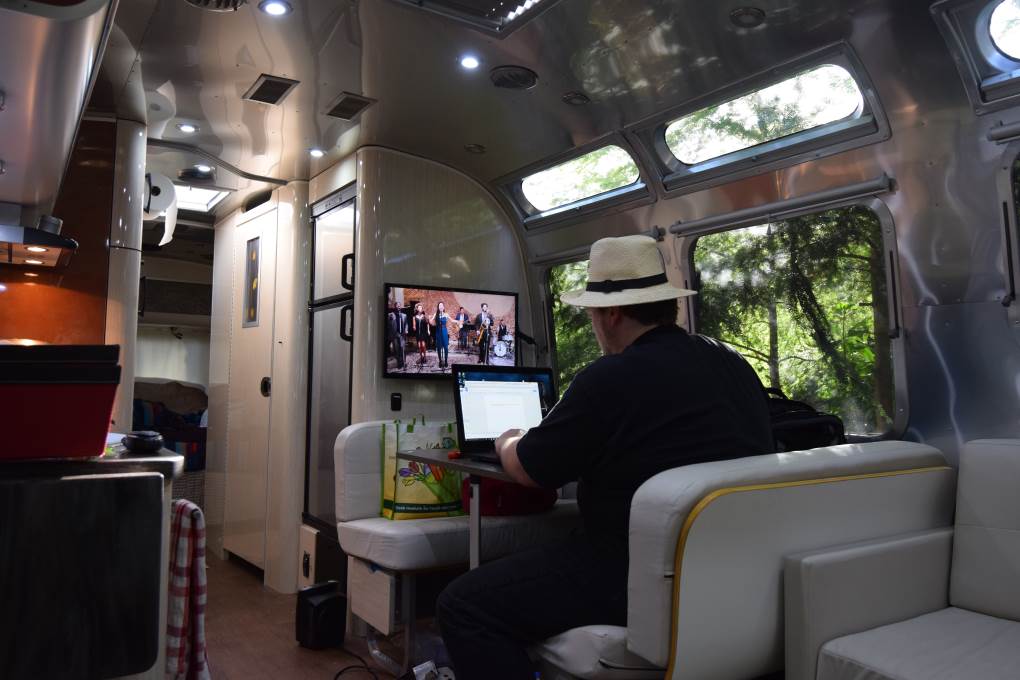
RV Electricity vs Propane
Your RV may have some appliances that can either run on electricity or propane. Heaters, water heaters, and refrigerators that can switch between the two are common.
The rule of thumb with these is that if you are connected to RV shore power, you should use the electricity option — or a hybrid electric and propane option if your rig comes with a hybrid system.
If you are boondocking —or camping off the grid — use the propane option. It really comes down to what you have more of and what operates your system best — propane or electricity.
Surge protectors
Some RVs have a built-in surge protector, and some have none at all, so you will have to buy an external portable surge protector.
The purpose of using a surge protector is to make sure the RV shore power is clean and steady before letting the electricity into the trailer; the surge protector acts as a guard from power surges both natural and unnatural.
Surge protectors are not essential, but they do help preserve the integrity of the RV’s electrical systems.
If you use a surge protector, be aware that there is usually a short delay from when you connect power to when the surge protector allows power to the RV. Typically it is around 20 to 60 seconds. This delay can be confusing if you are not aware of it.
1. Understanding RV Electrical Systems: AC vs. DC Power
Explain the difference between AC (alternating current) and DC (direct current) power in RVs. Discuss what types of devices use AC vs. DC, and why it’s important to know how both systems work together.
Example:
- AC power is used when connected to shore power or a generator, while DC is primarily used for the battery-powered system.
Example Keywords:
- RV AC power vs. DC power
- How RV electrical systems work
2. RV Battery Basics: Types, Maintenance, and Charging
Discuss the different types of RV batteries (e.g., lead-acid, lithium-ion), how to maintain them for optimal performance, and tips on proper charging. Include a focus on solar power compatibility.
Example Keywords:
- Best RV batteries
- RV battery maintenance tips
- How to charge RV batteries with solar
3. Common Electrical Problems in RVs and How to Fix Them
Offer solutions to frequent electrical issues RV owners face, such as flickering lights, tripped breakers, or battery drainage. Include practical troubleshooting steps.
Example Keywords:
- RV electrical troubleshooting
- How to fix RV electrical problems
- RV breaker keeps tripping
4. RV Power Sources: Shore Power, Generators, and Solar
Highlight the different ways to power an RV, explaining the pros and cons of shore power, generators, and solar setups. Discuss how to choose the right power source for your needs.
Example Keywords:
- RV shore power vs. generator
- Best RV solar setup
- How to connect RV to shore power
RV Insurance to Maximize Safety: The Power You Need
Understanding your RV’s electrical system is key to a successful trip, especially when you’re off-grid and relying on your own power sources. From managing your AC and DC systems to knowing the difference between shore power and a generator, getting the basics right gives you confidence on the road.
Just like knowing your amps from your volts, having the right protection for your rig is essential for a worry-free journey. RV insurance to maximize safety is what every adventurer seeks, and Roamly is the official insurance partner of Outdoorsy. They specialize in policies for adventurers, eliminating the commercial-use exclusion clause so your rig is “rent ready” and you’re protected whether you’re camping, traveling, or even renting it out. With Roamly, you can be sure your adventure is powered by peace of mind.
RV Electrical FAQs
1. Do I need a generator for my RV? Generators are useful when you can’t connect to shore power, especially when boondocking or dry camping. They help power appliances and recharge your batteries.
2. How do I know if my RV is 30 or 50 amp? You can check your RV’s electrical panel or consult your owner’s manual. Generally, larger RVs tend to have 50-amp systems, while smaller rigs have 30-amp systems.
3. Can I plug my RV into a regular household outlet? Yes, but you will need an adapter, and it’s important to note that household outlets provide only 15 or 20 amps, which may not power larger appliances effectively.
4. How long do RV batteries last? A typical lead-acid battery can last 3 to 5 years with proper maintenance, while lithium-ion batteries may last up to 10 years.
5. Why is my RV breaker tripping? Breaker tripping can be caused by overloading circuits, faulty wiring, or running too many high-power appliances at once. Try reducing your electrical load or checking for faulty wiring.
Before you go
Generally, operating an RV electrical system is a no-hassle situation, but it is important to know the basics so you can have a trouble-free adventure. If you want to learn more about the basics of RV electricity, check out Learning Your Way Around an RV.
Discover all our RV electricity articles here.
Are you feeling charged up? Ready to zap boredom with a grand RV Adventure?

